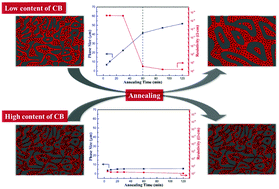Effect of phase coarsening under melt annealing on the electrical performance of polymer composites with a double percolation structure†
Abstract
The effect of phase coarsening on the evolution of the carbon black (CB) nanoparticle network under quiescent melt annealing and the electrical performance of polypropylene/polystyrene/carbon black (PP/PS/CB) composites with a double percolation structure was investigated. The results showed that when the CB content is low, the coarsening process of PP/PS/CB blends can be divided into two stages. In the first stage, the coarsening rate is fast before the formation of the CB nanoparticle network, and after annealing for a certain time, the evolution of the co-continuous morphology can drive the CB nanoparticles to self-assemble into a complete nanoparticle network. In the second stage, the coarsening rate is slow after the formation of the CB nanoparticle network. When the CB content is high, the CB nanoparticle network can be maintained throughout the whole annealing process, so that the conductivity and morphology of the PP/PS/CB composites are stable. Moreover, the electrical conductivity of the PP/PS/CB composites greatly increases after annealing for a certain time, and a percolation threshold as low as 0.07 vol% can be obtained. These results reveal the relationship between the evolution of the morphology and the conductivity in the conductive polymer composites with a double percolation structure, and provide a more in-depth and comprehensive understanding of the double percolation structure.



 Please wait while we load your content...
Please wait while we load your content...